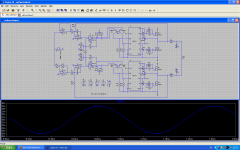A few days ago i found a pdf depicting a self oscillating class d with BD modulation, something i have never before seen and dident even know wat possible.
I had to come up with the component values myself but this is the basic circuit.
And a link to the paper for those interested: Low cost implementation of filterless class D audio amplifier with constant switching frequency_°Ù¶ÈÎÄ¿â
I had to come up with the component values myself but this is the basic circuit.
And a link to the paper for those interested: Low cost implementation of filterless class D audio amplifier with constant switching frequency_°Ù¶ÈÎÄ¿â
Attachments
Once again. As ham radio, I ask not to use filterless class D audio, they generate and irradiates large EMI as that speaker cables becomes an antenna.
And self oscillating, the amplifier moves in frequency in the audio rate, so interferences strongly disturb AM reception.
And self oscillating, the amplifier moves in frequency in the audio rate, so interferences strongly disturb AM reception.
Read the paper, its constant switching frequency, its not changing. Also note in my sim that there IS a output filter used, i also do not like filterless.
Filterless is generally only used where the amp is within inches of the speaker.
I know you do not like self osc, i did so myself until i discovered the way to stabilize a self osc so that it does not vary in switching freq.
Filterless is generally only used where the amp is within inches of the speaker.
I know you do not like self osc, i did so myself until i discovered the way to stabilize a self osc so that it does not vary in switching freq.
It appears that you don't read this paper. Clearly it is said that carrier frequency depend of the value of M, the modulation index. See figure 3 in your link.
I see a pair of 22uH inductors on the output. All is good.
If you're building this amp, I'd recommend changing the two 470n caps to a single 220n film cap (with twice the voltage rating) connected between the two outputs. Use a pair of 22n capacitors to ground. This reduces the amount of ripple current flowing through the circuit ground, which is good from an EMI perspective.
Feed the output through a common mode filter before you bring it out of the case.
If you're building this amp, I'd recommend changing the two 470n caps to a single 220n film cap (with twice the voltage rating) connected between the two outputs. Use a pair of 22n capacitors to ground. This reduces the amount of ripple current flowing through the circuit ground, which is good from an EMI perspective.
Feed the output through a common mode filter before you bring it out of the case.
Also, a self-oscillating amplifier will not be constant frequency. It'll be maximum frequency at zero output, and the frequency will drop as it gets close to the rails.
Unless you're doing some sort of trick where you feedforward the audio signal and dynamically adjust the control loop with it, but I don't see that here.
Unless you're doing some sort of trick where you feedforward the audio signal and dynamically adjust the control loop with it, but I don't see that here.
Again read the paper, it clearly states the "variable hysteresis" to obtain a constant switching frequency from zero to near 100% modulation.
Tekko, if you take 2 UCD modules and connect a 2.2nF cap between outputs of both modules you get same class-BD mode but also with post filter feedback.
No you do not! They need to be synchronized so that they run at not only the exact same switching frequency, but also in phase with each other. Only the audio signal is 180deg out of phase, thats how you get the BD mode.
Also the hypex ucd modules suffer the exact same switching frequency drop as a fixed hysteretic window class d, but also the UcD can be compensated for a constant switching freq by using complex zeros in the feedback path and what not.
Also the hypex ucd modules suffer the exact same switching frequency drop as a fixed hysteretic window class d, but also the UcD can be compensated for a constant switching freq by using complex zeros in the feedback path and what not.
No you do not! They need to be synchronized so that they run at not only the exact same switching frequency, but also in phase with each other. Only the audio signal is 180deg out of phase, thats how you get the BD mode.
Wrong...!!!
With the sync cap between 2 half bridge UCDs spk outputs + to + of both, the switching frequency becomes same and the phase also becomes same, only one has to feed out of phase audio signals at input.
One could argue that your constant frequency amplifier suffers unacceptably short on/off times at higher modulation, leading to excessive power dissipation 😉Byt they still suffer the unacceptable switching frequency drop as modulation goes up.
If you're close enough to the rails to make your switching frequency drop 4-8 times, that's an overdriven amp - not a fundamental problem with the amplifier architecture. Put more volts on the rails and you're good to go.Rather that than a 4-8x reduction in switching frequency near full modulation.
- Status
- Not open for further replies.
- Home
- Amplifiers
- Class D
- Self oscillating class d with BD modulation, it's possible!
